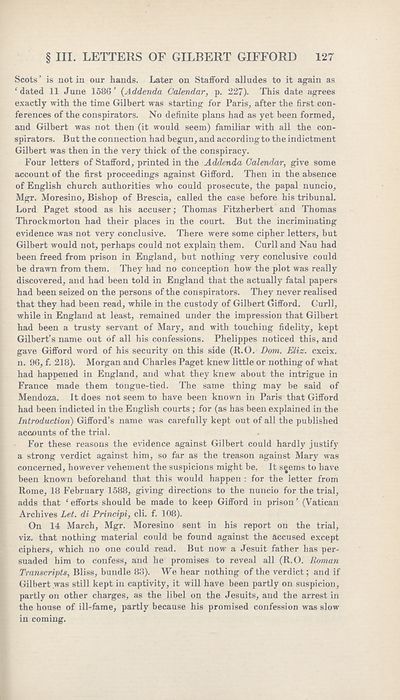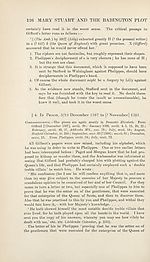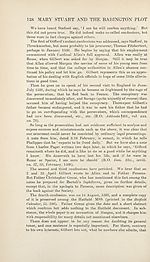Series 3 > Mary Queen of Scots and the Babington plot
(344) Page 127
Download files
Complete book:
Individual page:
Thumbnail gallery: Grid view | List view

§ III. LETTERS OF GILBERT GIFFORD 127
Scots ’ is not in our hands. Later on Stafford alludes to it again as
‘dated 11 June 1586’ {Addenda Calendar, p. 227). This date agrees
exactly with the time Gilbert was starting for Paris, after the first con¬
ferences of the conspirators. No definite plans had as yet been formed,
and Gilbert was not then (it would seem) familiar with all the con¬
spirators. But the connection had begun, and accordingto the indictment
Gilbert was then in the very thick of the conspiracy.
Four letters of Stafford, printed in the Addenda Calendar, give some
account of the first proceedings against Gifford. Then in the absence
of English church authorities who could prosecute, the papal nuncio,
Mgr. Moresino, Bishop of Brescia, called the case before his tribunal.
Lord Paget stood as his accuser; Thomas Fitzherbert and Thomas
Throckmorton had their places in the court. But the incriminating
evidence was not very conclusive. There were some cipher letters, but
Gilbert would not, perhaps could not explain them. Curll and Nau had
been freed from prison in England, but nothing very conclusive could
be drawn from them. They had no conception how the plot was really
discovered, and had been told in England that the actually fatal papers
had been seized on the persons of the conspirators. They never realised
that they had been read, while in the custody of Gilbert Gifford. Curll,
while in England at least, remained under the impression that Gilbert
had been a trusty servant of Mary, and with touching fidelity, kept
Gilbert’s name out of all his confessions. Phelippes noticed this, and
gave Gifford word of his security on this side (R.O. Dom. Eliz. cxcix.
n. 96, f. 218). Morgan and Charles Paget knew little or nothing of what
had happened in England, and what they knew about the intrigue in
France made them tongue-tied. The same thing may be said of
Mendoza. It does not seem to have been known in Paris that Gifford
had been indicted in the English courts; for (as has been explained in the
; Introduction) Gifford’s name was carefully kept out of all the published
accounts of the trial.
For these reasons the evidence against Gilbert could hardly justify
; a strong verdict against him, so far as the treason against Mary was
concerned, however vehement the suspicions might be. It sterns to have
been known beforehand that this would happen : for the letter from
Rome, 18 February 1588, giving directions to the nuncio for the trial,
adds that ‘efforts should be made to keep Gifford in prison’ (Vatican
- Archives Let. di Principi, cli. f. 108).
On 14 March, Mgr. Moresino sent in his report on the trial,
I viz. that nothing material could be found against the accused except
r ciphers, which no one could read. But now a Jesuit father has per¬
suaded him to confess, and he promises to reveal all (R.O. Homan
| Transcripts, Bliss, bundle 8.3). We hear nothing of the verdict; and if
I Gilbert was still kept in captivity, it will have been partly on suspicion,
f partly on other charges, as the libel on the Jesuits, and the arrest in
the house of ill-fame, partly because his promised confession was slow
? in coming.
Scots ’ is not in our hands. Later on Stafford alludes to it again as
‘dated 11 June 1586’ {Addenda Calendar, p. 227). This date agrees
exactly with the time Gilbert was starting for Paris, after the first con¬
ferences of the conspirators. No definite plans had as yet been formed,
and Gilbert was not then (it would seem) familiar with all the con¬
spirators. But the connection had begun, and accordingto the indictment
Gilbert was then in the very thick of the conspiracy.
Four letters of Stafford, printed in the Addenda Calendar, give some
account of the first proceedings against Gifford. Then in the absence
of English church authorities who could prosecute, the papal nuncio,
Mgr. Moresino, Bishop of Brescia, called the case before his tribunal.
Lord Paget stood as his accuser; Thomas Fitzherbert and Thomas
Throckmorton had their places in the court. But the incriminating
evidence was not very conclusive. There were some cipher letters, but
Gilbert would not, perhaps could not explain them. Curll and Nau had
been freed from prison in England, but nothing very conclusive could
be drawn from them. They had no conception how the plot was really
discovered, and had been told in England that the actually fatal papers
had been seized on the persons of the conspirators. They never realised
that they had been read, while in the custody of Gilbert Gifford. Curll,
while in England at least, remained under the impression that Gilbert
had been a trusty servant of Mary, and with touching fidelity, kept
Gilbert’s name out of all his confessions. Phelippes noticed this, and
gave Gifford word of his security on this side (R.O. Dom. Eliz. cxcix.
n. 96, f. 218). Morgan and Charles Paget knew little or nothing of what
had happened in England, and what they knew about the intrigue in
France made them tongue-tied. The same thing may be said of
Mendoza. It does not seem to have been known in Paris that Gifford
had been indicted in the English courts; for (as has been explained in the
; Introduction) Gifford’s name was carefully kept out of all the published
accounts of the trial.
For these reasons the evidence against Gilbert could hardly justify
; a strong verdict against him, so far as the treason against Mary was
concerned, however vehement the suspicions might be. It sterns to have
been known beforehand that this would happen : for the letter from
Rome, 18 February 1588, giving directions to the nuncio for the trial,
adds that ‘efforts should be made to keep Gifford in prison’ (Vatican
- Archives Let. di Principi, cli. f. 108).
On 14 March, Mgr. Moresino sent in his report on the trial,
I viz. that nothing material could be found against the accused except
r ciphers, which no one could read. But now a Jesuit father has per¬
suaded him to confess, and he promises to reveal all (R.O. Homan
| Transcripts, Bliss, bundle 8.3). We hear nothing of the verdict; and if
I Gilbert was still kept in captivity, it will have been partly on suspicion,
f partly on other charges, as the libel on the Jesuits, and the arrest in
the house of ill-fame, partly because his promised confession was slow
? in coming.
Set display mode to:
![]() Universal Viewer |
Universal Viewer | ![]() Mirador |
Large image | Transcription
Mirador |
Large image | Transcription
Images and transcriptions on this page, including medium image downloads, may be used under the Creative Commons Attribution 4.0 International Licence unless otherwise stated. ![]()
| Scottish History Society volumes > Series 3 > Mary Queen of Scots and the Babington plot > (344) Page 127 |
|---|
| Permanent URL | https://digital.nls.uk/127238169 |
|---|
| Attribution and copyright: |
|
|---|
| Description | Over 180 volumes, published by the Scottish History Society, containing original sources on Scotland's history and people. With a wide range of subjects, the books collectively cover all periods from the 12th to 20th centuries, and reflect changing trends in Scottish history. Sources are accompanied by scholarly interpretation, references and bibliographies. Volumes are usually published annually, and more digitised volumes will be added as they become available. |
|---|


